Gigabyte GeForce GTX 980 Ti Xtreme Gaming Windforce Review
Gigabyte's GeForce GTX 980 Ti Xtreme Gaming might just be the fastest single-GPU graphics card we've ever tested. It features a custom PCB, binned and overclocked processor, and robust cooling.
Why you can trust Tom's Hardware
Overclocking, Noise, Temperature And Power
Overclocking OC Guru II
To unlock the full potential of Gigabyte's graphics cards, the company supplies its own overclocking utility called OC Guru II. This software allows for adjustment to a number of the graphics card's parameters.

For instance, the GPU core clock can be adjusted in 1MHz increments. Same goes for the memory frequency. Target Power and Target Temp can also be adjusted in a granular manner. The power maxes out at 130 percent, and the temperature can be set as high as 91 degrees Celsius. Core Voltage is adjustable in 0.0125V increments.
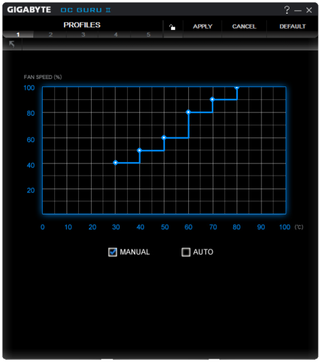
OC Guru II is also used to manage the card's fan profile. By default, the fans switch off any time the GPU temperature falls below 60 degrees. Choosing a manual profile lets you keep the fans running all of the time to bring temps down even further.

Gigabyte's GeForce GTX 980 Ti Xtreme Gaming includes a set of RGB LED fan lights and an illuminated WindForce logo, controlled through OC Guru II. The lights have seven preset colors, and the software includes a mode to cycle between all of them. There is also an option to select any color you wish with a slider bar. In addition to picking a color, you can choose between static, breathing, flashing and a dual-flashing behavior.
Overclocking
Gigabyte's GTX 980 Ti Xtreme Gaming is already aggressively overclocked from the factory. But the company wouldn't have binned its GPUs, engineered a custom PCA, installed an oversized cooler and developed a LN2-specific firmware if it didn't expect enthusiasts to push the hardware even further. There's even a special overclock setting to increase the core clock another 25MHz.
That became our starting point for manual tuning. Before embarking on our own overclocking journey, we ran a baseline in 3DMark. From there, we increased the core clock another 25MHz and maxed out the power limit.
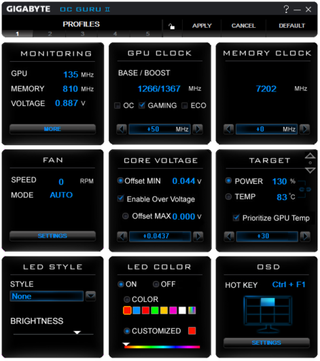
We increased the GPU clock rate in 5MHz intervals up to 1276MHz, at which point the system encountered a lock-up during the second test in 3DMark. Ultimately, 1266MHz proved to be the highest stable GPU frequency.
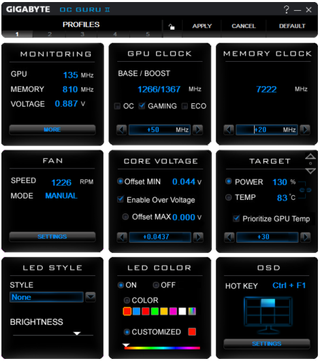
After locking in an optimal GPU overclock, we shifted attention to the memory. Gigabyte configures its GDDR5 modules to operate at 7202 MT/s, which is already one of the highest transfer rates we've ever seen. As it turns out, the memory doesn't want to be pushed much harder. Beyond 7222 MT/s, the GTX 980 Ti Xtreme Gaming doesn't make it through 3DMark.

Ultimately, we were able to increase the core clock rate by 40MHz and the memory by 20MHz, though that proved to be of little value in our benchmark suite.
Temperature
We took two temperature measurements for the Gigabyte GTX 980 Ti Xtreme Gaming card. The automatic fan profile and the default settings when switching to manual were tested as well. As you can see, both profiles demonstrate dramatically different patterns, which interestingly mirror the results of two configurations used for comparison.
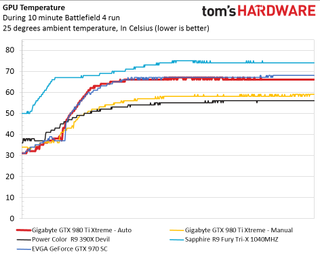
The automatic profile ramped up with almost the exact pattern used by EVGA's GTX 970 SC. Meanwhile, the manual profile showed similar temperature levels compared to the water-cooled PowerColor Devil R9 390X.
These tests were run in one sitting, and the GPU was manually cooled down between them to speed up the process. Several days later, after the GPU had been sitting idle with its fans disabled, we saw the GPU temperature at 58 degrees. If you don't have much airflow in your case, consider a manual profile that keeps the fans spinning.
Noise
Gigabyte's GTX 980 Ti Extreme Gaming may share a similar temperature profile as EVGA's GTX 970 SC, but it certainly doesn't output the same sound levels. This is truly one of the quietest cards in our lab. Sapphire's Tri-X cooler manages a slightly lower ceiling, but at 38.5 decibels the Gigabyte card is still very quiet.
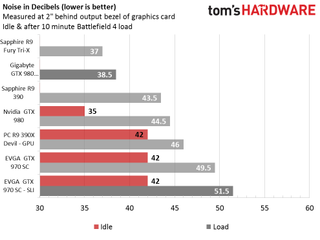
The automatic profile shuts the fans off completely at idle, resulting in silent operation. After about 10 minutes of game play, the fans spin up to audible levels. But in a room with other ambient noise, you're not going to hear them.
Power
Nvidia's Maxwell architecture is famous for its efficiency, delivering incredible performance per watt of power consumption. Gigabyte's take on the flagship results in one of the fastest single-GPU boards you can buy, so it's no surprise that this card uses more power than its lower-end competition.
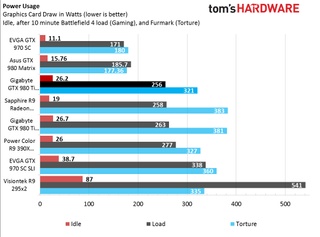
It was somewhat surprising to see just how much power the card uses at idle, though. Drawing 26.2W puts it in the same range as PowerColor’s overclocked R9 390X, a card well-known for posting big consumption figures. Under full load, the GeForce GTX 980 Ti Xtreme Gaming draws practically the same amount of power as Sapphire's R9 Fury Tri-X. Still, two GTX 970s in SLI and the VisionTek R9 295X2 show that this single-GPU card is far more efficient than two processors working cooperatively.
MORE: Best Graphics CardsMORE: All Graphics Content
Current page: Overclocking, Noise, Temperature And Power
Prev Page Gaming Benchmarks Next Page ConclusionStay on the Cutting Edge
Join the experts who read Tom's Hardware for the inside track on enthusiast PC tech news — and have for over 25 years. We'll send breaking news and in-depth reviews of CPUs, GPUs, AI, maker hardware and more straight to your inbox.
Kevin Carbotte is a contributing writer for Tom's Hardware who primarily covers VR and AR hardware. He has been writing for us for more than four years.
-
Gam3r01 I am mostly interested to see how it would stack up against an MSI Lightning or the ASUS Strix cards.Reply -
dstarr3 Ehh, if you keep waiting for the next best thing, you'll be waiting an eternity, because something newer and better is always just around the bend. Don't buy the next flagship Pascal card, wait for the Ti version. But don't buy that, wait for the next generation of Pascal because that'll be even more powerful and efficient, while being quieter. But don't buy that either, wait for the Ti.Reply
I picked up a 980 Ti last month and I love it, and I won't need a new card for several years now. There's a lot to be said about waiting, but you gotta take the plunge eventually. -
beshonk That's because it's a dual GPU card...You just proved you have no idea what you're talking about.Reply -
-Fran- ReplyThat's because it's a dual GPU card...You just proved you have no idea what you're talking about.
The Nissan GTR puts less than 3 seconds from 0 to 60 using a twin turbo V6 and beats exotic cars using V10s that cost 2 to 3 times more.
Unless you're brand loyal or actually care about multi GPU issues, dismissing the 295 just because is a dual GPU card is weird in my eyes.
--
I kinda missed the Fury X in there and nice showing by that 390X. Beating the 980 in a lot of tests. Too bad the consumption numbers are so bad.
Nice card none the less. I'll wait for the new batch of cards though to replace my lovely 7970Ghz.
Cheers! -
artk2219 Reply17344858 said:Lol at the R9 295x2 winning most of the benchmarks handily.
Thats what happens when its going against two 290X's, but the 980 TI doesn't have to deal with micro stuttering, it uses a whole lot less power, and puts out less heat. But, the 295's were priced really nicely when they were readily available. I saw one new open box at microcenter for $495 a few months ago, and I didn't pick it up... I still kind of regret that, I had it in my literal hands and everything :-/.
-
Epsilon_0EVP ReplyEhh, if you keep waiting for the next best thing, you'll be waiting an eternity, because something newer and better is always just around the bend. Don't buy the next flagship Pascal card, wait for the Ti version. But don't buy that, wait for the next generation of Pascal because that'll be even more powerful and efficient, while being quieter. But don't buy that either, wait for the Ti.
I picked up a 980 Ti last month and I love it, and I won't need a new card for several years now. There's a lot to be said about waiting, but you gotta take the plunge eventually.
The difference in this case is that we're having a massive die shrink for the first time in 4 years. Pascal and Polaris cards are likely to completely wreck the current cards in performance per watt, which could mean ridiculous performance gains as well. In this specific scenario, waiting is not a bad idea.
-
ael00 looks like a beastie. I especially like the fact that it shares the tank constructions of the 980/970 g1 series.Reply
Im sure if it wasn't 6 months late it would have dominated the 980ti/R9 fury market segment. No rgb fans will stop people hoarding cash for pascal tho ...
